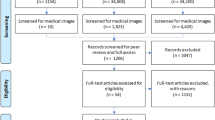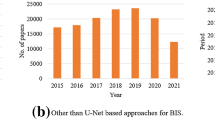Abstract
Nowadays, the medical field is enriched with rich technologies, especially with a medical image processing system. However, the image complexity has minimized the prediction and segmentation exactness rate requiring additional duration to execute the process. The current design article has focused on developing a novel Bat-based Generative Adversarial Model (BGAM) to gain the finest substructure localization and segmentation results to overcome this difficulty. Here, the fitness of Bat is updated in the classification layer of the generative adversarial approach to gain the tuned results. Finally, the designed model is validated with dual cases that are conventional generative adversarial models without a bat and generative adversarial models with the Bat. Moreover, the evaluation has produced the finest results for BGAM compared to the conventional generative approach. The designed novel approach is executed in a python environment, and the proficiency of the developed system is validated with other associated approaches. It has proved the finest outcome by earning the highest specificity and sensitivity rate.














Similar content being viewed by others
Data availability
Data sharing not applicable to this article as no datasets were generated or analysed during the current study.
References
Aggarwal A, Mittal M, Battineni G (2021) Generative adversarial network: An overview of theory and applications. Int J Inf Manag Data Insights 1(1):100004. https://doi.org/10.1016/j.jjimei.2020.100004
Ali A, Zhu Y, Chen Q, Yu J, Cai H (2019) Leveraging Spatio-temporal patterns for predicting citywide traffic crowd flows using deep hybrid neural networks. 2019 IEEE 25th international conference on parallel and distributed systems (ICPADS), pp 125-132. https://doi.org/10.1109/ICPADS47876.2019.00025
Ali A, Zhu Y, Zakarya M (2021) A data aggregation based approach to exploit dynamic spatio-temporal correlations for citywide crowd flows prediction in fog computing. Multimed Tools Appl 80:31401–31433. https://doi.org/10.1007/s11042-020-10486-4
Ali A, Zhu Y, Zakarya M (2021) Exploiting dynamic Spatio-temporal correlations for citywide traffic flow prediction using attention-based neural networks. Inf Sci 577:852–870. https://doi.org/10.1016/j.ins.2021.08.042
Arts H, van Erp WS, Boon LI, Bosman CA et al (2020) Awakening after a sleeping pill: restoring functional brain networks after severe brain injury. Cortex 132:135–146. https://doi.org/10.1016/j.cortex.2020.08.011
Avendaño-Valencia LD, Yderstræde KB, Nadimi ES, Blanes-Vidal V (2021) Video-based eye tracking performance for computer-assisted diagnostic support of diabetic neuropathy. Artif Intell Med 114:102050. https://doi.org/10.1016/j.artmed.2021.102050
Bouhrara M, Cortina LE, Rejimon AC, Khattar N, Bergeron C, Bergeron J, Melvin D, Zukley L, Spencer RG (2020) Quantitative age-dependent differences in human brainstem myelination assessed using high-resolution magnetic resonance mapping. NeuroImage 206:116307. https://doi.org/10.1016/j.neuroimage.2019.116307
Creswell A, Bharath AA (2018) Inverting the generator of a generative adversarial network. IEEE Trans Neural Netw Learn Syst 30(7):1967–1974. https://doi.org/10.1109/TNNLS.2018.2875194
Cronin NJ, Finni T, Seynnes O (2020) Using deep learning to generate synthetic B-mode musculoskeletal ultrasound images. Comput Methods Prog Biomed 196:105583. https://doi.org/10.1016/j.cmpb.2020.105583
Dutt S, Li Y, Mather M, Nation DA (2021) Brainstem substructures and cognition in prodromal Alzheimer's disease. Brain Imaging Behav 15:1–11. https://doi.org/10.1007/s11682-021-00459-y
Elzayady M, Debees NL, Khalil M, Dawoud MM (2021) Cerebellum and brain stem volume loss in relapsing remission multiple sclerosis by MRI volumetry: relation to neurological disability score and number of relapses. Egypt J Radiol Nucl Med 52(1):1–9. https://doi.org/10.1186/s43055-020-00394-w
Gao X, Saha RK, Prasad MR, Roychoudhury A (2020) Fuzz testing based data augmentation to improve robustness of deep neural networks. 2020 IEEE/ACM 42nd international conference on software engineering (ICSE), IEEE
Han B, Zhang X, Wang J, An Z, Jia S, Zhang G (2021) Hybrid distance-guided adversarial network for intelligent fault diagnosis under different working conditions. Measurement 176:109197. https://doi.org/10.1016/j.measurement.2021.109197
Huang J, Le Z, Ma Y, Fan F, Zhang H, Yang L (2020) MGMDcGAN: medical image fusion using multi-generator multi-discriminator conditional generative adversarial network. IEEE Access 8:55145–55157. https://doi.org/10.1109/ACCESS.2020.2982016
Iqbal T, Qureshi S (2020) The survey: text generation models in deep learning. J King Saud Univ-Comput Inf Sci https://doi.org/10.1016/j.jksuci.2020.04.001
Kann BH, Hosny A, Aerts HJWL (2021) Artificial intelligence for clinical oncology. Cancer Cell 39(7):916–927. https://doi.org/10.1016/j.ccell.2021.04.002
Kong F, Huang B, Bradbury K, Malof J (2020) The Synthinel-1 dataset: a collection of high-resolution synthetic overhead imagery for building segmentation. Proceedings of the IEEE/CVF winter conference on applications of computer vision, pp 1814-1823
Lechanoine F, Jacquesson T, Beaujoin J, Serres B, Mohammadi M, Planty-Bonjour A, Andersson F, Poupon F, Poupon C, Destrieux C (2021) WIKIBrainStem: An online atlas to manually segment the human brainstem at the mesoscopic scale from ultra-high field MRI. NeuroImage 236:118080. https://doi.org/10.1016/j.neuroimage.2021.118080
Nair S, Shroff SS (2021) Vascular anomalies of the Oro-maxillofacial region. Oral and Maxillofacial Surgery for the Clinician. Springer, Singapore, pp 629–658. https://doi.org/10.1007/978-981-15-1346-6_31
Pirovano A, Almeida LG, Ladjal S, Bloch I (2021) Computer-aided diagnosis tool for cervical cancer screening with weakly supervised localization and detection of abnormalities using the adaptable and explainable classifier. Med Image Anal 73:102167. https://doi.org/10.1016/j.media.2021.102167
Rizvi SKJ, Azad MA, Fraz MM (2021) Spectrum of advancements and developments in multidisciplinary domains for generative adversarial networks (gans). Arch Computat Methods Eng 28:1–19. https://doi.org/10.1007/s11831-021-09543-4
Shi H, Koronyo Y, Rentsendorj A, Regis GC, Sheyn J, Fuchs DT, Kramerov AA, Ljubimov AV, Dumitrascu OM, Rodriguez AR, Barron E, Hinton DR, Black KL, Miller CA, Mirzaei N, Koronyo-Hamaoui M (2020) Identification of early pericyte loss and vascular amyloidosis in Alzheimer's disease retina. Actaneuropathologica 139:1–24. https://doi.org/10.1007/s00401-020-02134-w
Singh RK, Pandey R, Babu RN (2021) COVIDScreen: explainable deep learning framework for differential diagnosis of COVID-19 using chest X-rays. Neural Comput Applic 33:1–22. https://doi.org/10.1007/s00521-020-05636-6
Sjöström H, Granberg T, Hashim F, Westman E, Svenningsson P (2020) Automated brainstem volumetry can aid in the diagnostics of parkinsonian disorders. Parkinsonism Relat Disord 79:18–25. https://doi.org/10.1016/j.parkreldis.2020.08.004
Tang Q (2020) Rebirth mythology: the source of the symbolic significance of the capping ritual. Ritual Civilization and Mythological Coding. Springer, Singapore, pp 1–104. https://doi.org/10.1007/978-981-15-4393-7_1
Uppal S, Bhagat S, Hazarika D, Majumder N, Poria S, Zimmermann R, Zadeh A (2021) Multimodal research in vision and language: a review of current and emerging trends. Inf Fusion 77:149–171. https://doi.org/10.1016/j.inffus.2021.07.009
Usman M, Farooq M, Wakeel A, Nawaz A, Cheema SA, Rehman HU, Ashraf I, Sanaullah M (2020) Nanotechnology in agriculture: current status, challenges and future opportunities. Sci Total Environ 721:137778. https://doi.org/10.1016/j.scitotenv.2020.137778
Wang G, Song T, Dong Q, Cui M, Huang N, Zhang S (2020) Automatic ischemic stroke lesion segmentation from computed tomography perfusion images by image synthesis and attention-based deep neural networks. Med Image Anal 65:101787. https://doi.org/10.1016/j.media.2020.101787
Wang F, Liu H, Samaras D, Chen C (2020) Topogan: A topology-aware generative adversarial network, Computer Vision–ECCV 2020: 16th European Conference, Glasgow, UK, August 23–28, 2020. Proceedings, part III 16, Springer International Publishing https://doi.org/10.1007/978-3-030-58580-8_8
Wani IM, Arora S (2020) Computer-aided diagnosis systems for osteoporosis detection: a comprehensive survey. Med biol Eng Comput 1-45. 58:1873–1917. https://doi.org/10.1007/s11517-020-02171-3
Wei L, El Naqa I (2021) Fundamentals of Radiomics in nuclear medicine and hybrid imaging. Basic Sciences of Nuclear Medicine, Springer, Cham, pp 441–469. https://doi.org/10.1007/978-3-030-65245-6_17
Xiao Y, Lu M, Fu Z (2020) Covered face recognition based on deep convolution generative adversarial networks. International Conference on Artificial Intelligence and Security, Springer, Cham https://doi.org/10.1007/978-3-030-57884-8_12
Yuvapriya T, Lakshmi P (2021) Numerical analysis and performance enhancement of active suspension system using bat optimization. Int J Dynam Control 9(2):590–601. https://doi.org/10.1007/s40435-020-00664-5
Zhang YD, Dong Z, Wang SH, Yu X, Yao X, Zhou Q, Hu H, Li M, Jiménez-Mesa C, Ramirez J, Martinez FJ, Gorriz JM (2020) Advances in multimodal data fusion in neuroimaging: overview, challenges, and novel orientation. Inf Fusion 64:149–187. https://doi.org/10.1016/j.inffus.2020.07.006
Zhou SK, Greenspan H, Davatzikos C, Duncan JS, Ginneken BV, Madabhushi A, Prince JL, Rueckert D, Summers RM (2021) A review of deep learning in medical imaging: imaging traits, technology trends, case studies with progress highlights, and future promises. Proceedings of the IEEE, pp 820-838. https://doi.org/10.1109/JPROC.2021.3054390
Author information
Authors and Affiliations
Corresponding author
Ethics declarations
Disclosure of potential conflict of interest
The authors declare that they have no potential conflict of interest.
Statement of human and animal rights
None
Ethical approval
All applicable institutional and/or national guidelines for the care and use of animals were followed.
Informed consent
For this type of study formal consent is not required.
Additional information
Publisher’s note
Springer Nature remains neutral with regard to jurisdictional claims in published maps and institutional affiliations.
Rights and permissions
Springer Nature or its licensor holds exclusive rights to this article under a publishing agreement with the author(s) or other rightsholder(s); author self-archiving of the accepted manuscript version of this article is solely governed by the terms of such publishing agreement and applicable law.
About this article
Cite this article
Srikanth, B., Jayaprada, S., Kumar, K.K. et al. An optimized generalized adversarial system for predicting specific substructures in brainstem. Multimed Tools Appl 82, 7181–7205 (2023). https://doi.org/10.1007/s11042-022-13663-9
Received:
Revised:
Accepted:
Published:
Issue Date:
DOI: https://doi.org/10.1007/s11042-022-13663-9




